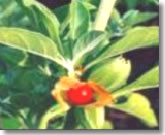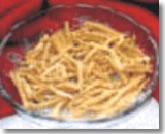
ASHVAGANDHA
Botanical Name: Withania somnifera
English Name: Indian ginseng
Hindi Name: Asgandh

Introduction: It is the most popular medicinal plant internationally. It is known to Indian medicine from early times. Paipalada Samhita quoted its root in the treatment of infertility ( P.S. 1/89/3), Charaka considered this as balya (tonic) and brimhana (nourishing). For centuries Ashvagandha is know for its aphrodisiac property and for its efficacy in male infertility. Today it is world over utilized for its anti-arthritic, anti- oxidant, immunomodulatory, aphrodisiac and tranquilizing effects.
Distribution: It is a erect under shrub, which is found throughout the drier and subtrophical India. It is cultivated extensively throughout India at present.
Chemical Constituents: Withaferin A, withanone, withanolide WS-1, Withanolide A to Y, Somnirol, somnitol, withasomniferinA, nicotine, withasomnine, sominone, sominolide etc.
Parts Used: Roots.
Properties: Bitter – acrid- astringent, nutritious, tonic, anti- inflammatory, tranquilizing, anti-arthritic, anti-oxidant etc.
Indications: Inflammation, leucoderma, immunodeficiency states, insomnia, arthritis, emaciation/ malnourishment, impotency etc.
Dose: root powder 3-6g twice daily.
Therapeutic Uses:
- Urinary obstruction: Decoction of its root will be a useful recipe.
- Insomnia: Powder of Ashvagandha shall be taken with ghee and sugar.
Scientific Studies:
Anti-stress activity: A quantitative reduction in anxiety level and neuroticism was noticed ( Singh et al., 1977). Potentiation of barbiturate hypnosis is seen (Singh et al., 1979).
Anti-inflammatory activity: Showed clinical improvement in RA, OA and periarthritis ( Bector et al., 1976). AE of defatted seeds on i.p. showed a significant antipyretic, analgesic and anti-inflammatory activity (Singh et al., 1978). Root powder exhibited considerable reduction in inflammation in rats ( Anabalagan & Sidique, 1981).
Immunosuppressive activity: Total withanolide inhiobited the proliferation of murine spleen cell cultures in vitro ( Bahr & Hansel, 1982).
Anti-tumour activity: Anti-cancer activity is reported by Amala Cancer Institute, Trissur ( Davis & Kuttan, 2001).
Cultivation Technology: Sandy loam or light red soils with pH between 7.5-8 are ideal. It is a Kharif crop. Propagated either by direct sowing or by transplantation. Seeds sown directly in the field and plants thinned 25 das after sowing ( 20,000-25,000 per hectare) OR 2kg seeds are sown per hectare to provide seedlings which are transplanted after 6 weeks in 60 cm wide furrows at 60 cm apart.
Harvesting: From January-March ( 150-170 days after sowing). Maturity of crop is judged by drying of leaves and red berries. Plant uprooted and root is cut-seperated in to 7-10 m pieces and dried. About 400-500 kg or roots & 50 kg of seeds are obtains per hectare. Rate per kg is about Rs. 70-80 i.e., about Rs. 32,000 to Rs. 40,000 per hectare.







